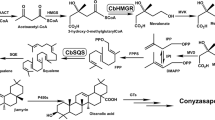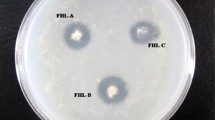Abstract
Anarom gene was cloned from genomic DNA ofScleortinia sclerotiorum by inverse PCR. The evolutionary relationships ofS. sclerotiorum and other fungi inarom gene were studied. Results showed that thearom gene from ofS. sclerotiorum has a single open reading frame of 4773 bp and does not include any introns. The derived amino acid sequence consists of 1 590 residues, and it is homologous to all fungal AROM proteins studied so far. The theoretical isoelectric point (pI) and molecular weight (Mw) is 6.5 and 172.66 kD, respectively. GC percentage of thearom gene is 44.94. According to the results of searching from CDD and Prosite database, AROM protein ofS. sclerotiorum contains five conserve domains: 3-dehydroquinate synthase domain, 3-dehydroquinate dehydratase (3-dehydroquinase) domain, shikimate 5-dehydrogenase domain, shikimate kinase domain, and-enolpyruvylshikimate-3-phosphate synthase (EPSP sythase) domain, and four motifs: two EPSP synthase signatures, dehydroquinase class I active site, shikimate kinase signature. According to the PIR Site Rule PIRSR000514-1, four functionally important amino acid residues are found by alignment. Putative TATA box and CAAT box locate separately in −23 and −77 loci in 5′ un-translated region, and two loci found in downstreamarom gene are likely polyadenylation signals. In addition, phylogeny ofarom gene is analyzed.
Similar content being viewed by others
References
Banerji, S., Wakefield, A.E., Allen, A.G., Maskell, D.J., Peters, S.E., Hopkin, J.M. 1993. The cloning and characterization of thearom gene ofPneumocystis carinii [J]. J Gen Microbiol,139(12): 2901–2914.
Charles, I.G., Keyte, J.W., Brammar, W.J., Smith, M., Hawkins, A.R. 1986. The isolation and nucleotide sequence of the complex AROM locus ofAspergilus nidulans [J]. Nucleic Acids Research,14(5): 2201–2213.
Deka, R.K., Kleanthous, C., Coggins, J.R. 1992. Identification of the essential histidine residue at the active site ofEscherichia coli dehydroquinase [J]. J Biol Chem,267(31): 22237–22242.
Duncan, K., Edwards, R.M., Coggins, J.R. 1987. The pentafunctional arom enzyme ofSaccharomyces cerevisiae is a mosaic of monofunctional domains [J]. Biochem J,246(2): 375–386.
Duncan, K., Edwards, R.M., Coggins, J.R. 1988. TheSaccharomyces cerevisiae ARO1 gene: an example of the co-ordinate regulation of five enzymes on a single pathway [J]. FEBS Letters,241(1–2): 83–88.
Fink, G.R. 1986. Translational control of transcription in eukaryotes [J]. Cell,45(2): 155–156.
Giles, N.H., Case, M.E., Partridge, C.W.H., Ahmed, S.I. 1967. A gene cluster inNeurospora crassa coding for an aggregate of five aromatic synthetic enzymes [J]. Genetics,58: 1453–1460.
Hawkins, A.R., Lamb, H.K., Roberts, C.F. 1991. Structure of theAspergillus nidulans qut repressor-encoding gene: implications for the regulation of transcription initiation [J]. Gene,110(1): 109–114.
Marchler-Bauer, A., Anderson, J.B., DeWeese-Scott, C., Fedorova, N.D., Geer, L.Y., He, S., Hurwitz, D.I., Jackson, J.D., Jacobs, A.R., Lanczycki, C.J., Liebert, C.A., Liu, C., Madej, T., Marchler, G.H., Mazumder, R., Nikolskaya, A.N., Panchenko, A.R., Rao, B.S., Shoemaker, B.A., Simonyan, V., Song, J.S., Thiessen, P.A., Vasudevan, S., Wang, Y., Yamashita, R.A., Yin, J.J., Bryant, S.H. 2003. CDD: a curated Entrez database of conserved domain alignments [J]. Nucleic Acids Research,31(1): 383–387
McDowell, L.M., Schmidt, A., Cohen, E.R., Studelska, D.R., Schaefer, J. 1996. Structural constraints on the ternary complex of 5-enolpyruvylshikimate-3-phosphate synthase from rotational-echo double-resonance NMR [J]. J Mol Biol,256: 160–171.
Padgette, S.R., Re, D.B., Gaser, C.S., Eichholtz, D.A., Frazier, R.B., Hironaka, C.M., Levine, E.B., Shah, D.M., Fraley, R.T., Kishore, G.M. 1991. Site-directed mutagenesis of a conserved region of the 5-enolpyruvylshikimate-3-phosphate synthase active site [J]. J Biol Chem,266(33): 22364–22369.
Walker, J.E., Saraste, M., Runswick, M.J., Gay, N.J. 1982. Distantly related sequences in the alpha- and beta-subunits of ATP synthase, myosin, kinases and other ATP-requiring enzymes and a common nucleotide binding fold [J]. EMBO J,1(8): 945–951.
Sambrook, J., Russell, D.W. 2002. Molecular Cloning: A laboratory Manual, 3rd Ed [M]. New York: Cold Spring Harbor Laboratory Press.
Saraste, M., Sibbald, P.R., Wittinghofer, A. 1990. The P-loop—a common motif in ATP- and GTP-binding proteins [J]. Trends Biochem Sci,15: 430–434.
Author information
Authors and Affiliations
Additional information
Biography: YANG Qian (1959-), male, Ph. D., Professor of Harbin Institute of Technology, Harbin 150001, P.R. China.
Responsible editor: Song Funan
Rights and permissions
About this article
Cite this article
Qian, Y., Han-ying, Y. & Chang-yin, L. Cloning and sequence analysis ofarom gene fromSclerotinia sclerotiorum . Journal of Forestry Research 16, 260–264 (2005). https://doi.org/10.1007/BF02858185
Received:
Accepted:
Issue Date:
DOI: https://doi.org/10.1007/BF02858185




